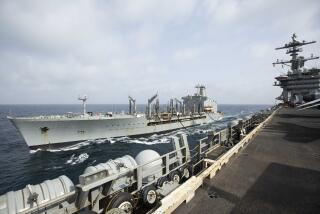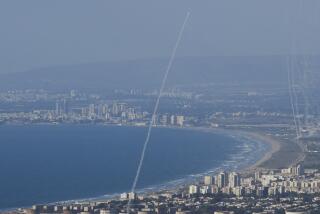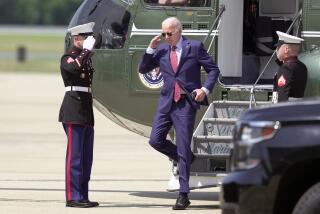10 GIs Believed Killed in Crashes of 3 Gulf Aircraft
DHAHRAN, Saudi Arabia â Ten American servicemen were believed killed in the crashes of three military aircraft Monday in the worst day of casualties in the region since the U.S. military buildup began in Saudi Arabia.
Among the missing were eight Camp Pendleton-based Marines whose two Huey helicopters vanished abruptly from radar screens on a night mission over the Arabian Sea. Rescue teams found debris from at least one of the helicopters floating in the water, but there was no sign of survivors, military officials said.
In the other incident, two Alabama Air National Guardsmen died when their Phantom reconnaissance plane crashed in the southern Arabian Peninsula. The cause of the crash was being investigated.
The deaths would bring to 16 the number of American military personnel killed in the theater since the U.S. deployment began two months ago. Thirteen more died in late August in Germany in the crash of a U.S. C-5A transport plane that was ferrying cargo to the Persian Gulf region.
The death toll for Operation Desert Shield, even in the absence of war, appears already to exceed the total of 23 U.S. servicemen killed in Panama when U.S. forces invaded that country last December.
In Washington, Defense Secretary Dick Cheney said it is always tragic when U.S. military personnel are killed. But he argued that the danger of accidental death is no greater in the Persian Gulf than it is in other places where U.S. military forces train and conduct operations.
âA loss of life of U.S. military personnel is something that we try to avoid . . . but when you are operating the kind of equipment that they do . . . there are, from time to time, accidents,â Cheney said.
He said helicopter operations over the Arabian Sea or Persian Gulf are âno different than operating at sea elsewhere.â
A Navy spokesman in Dhahran, Saudi Arabia, said the search for the downed helicopters is continuing in a mission involving three San Diego-based ships. But nearly 20 hours after the two aircraft disappeared, other military officials said there was little hope of rescuing any survivors.
Military officials here said the four pilots and four crew members on the two downed helicopters were part of a search-and-rescue squadron based at the Marine Corps Air Station at Camp Pendleton.
In Washington on Monday night, Maj. Nancy LaLuntas, a Marine Corps spokeswoman, identified the missing Marines as Capt. William D. Cronin Jr., Capt Gary S. Dillon, Capt. Kevin R. Dolvin, Capt. William J. Hurley, Sgt. Kenneth T. Keller, Sgt. John R. Kilkus, Cpl. Timothy W. Romei and Lance Cpl. Thomas R. Adams. Their ages and hometowns were not available.
The pre-dawn incident was the sixth in a series of nighttime accidents involving U.S. helicopters in the region, although all the pilots were wearing night vision goggles. Before Monday, five helicopters had been destroyed and nine servicemen injured in the incidents.
Navy officials said the Marine aircraft crews were conducting routine night operations about 8 miles from their shipboard base when radar and radio contact was lost at 5:13 a.m. local time. The simultaneous disappearance of the two choppers immediately gave rise to speculation that they had collided, but military officials said only that the cause of the crash remained under investigation.
The ship leading the search, the San Diego-based Okinawa, is part of an 18-ship task force carrying more than 10,000 Marines in the northern Arabian Sea in preparation for a possible amphibious assault on Iraqi-occupied Kuwait. Elements of the task force last week conducted a practice assault on a remote beachhead in Oman in an operation code-named Camel Sand.
The Okinawa was joined in its search for the downed helicopters by two other vessels based in San Diego, the amphibious cargo ship Durham and the tank landing ship Cauga.
The Air Force accident later Monday was described only as taking place in the southern Arabian Peninsula--a designation that usually indicates a site in a country outside Saudi Arabia. The downed plane, an âF-4C Phantom, is used for photo reconnaissance.
The airmen killed were identified as Maj. Barry Henderson, 40, the pilot, of Tuscumbia, Ala., and Maj. Stephen Schramm, 43, the navigator, of Birmingham, Ala.
Also Monday, U.S., British and Australian warships fired warning shots across the bow of an Iraqi cargo vessel in the Gulf of Oman in a joint interception that the official Iraqi News Agency condemned as piracy.
U.S. Coast Guardsmen and Royal Marines enforcing the U.N.-backed embargo on Iraq boarded the vessel Al Wasitti but found it to be empty and permitted it to continue on its way toward an Iraqi port.
The incident, which took place early Monday about 60 miles northeast of Muscat, involved the U.S. frigate Reasoner, the Royal Navyâs Battleaxe and the Australian navyâs Adelaide.
The commander of U.S. naval forces in the Persian Gulf told reporters that the Iraqi ships are now incapable of penetrating the naval blockade that the United States and other Western navies have erected around Iraq.
Vice Adm. Henry H. Mauz, commander of U.S. Naval Forces Central Command and the U.S. 7th Fleet, told reporters that many Iraqi merchant ships and tankers laden with cargo have now anchored outside the gulf, Reuters news agency reported from aboard the command ship Blue Ridge.
âThey are generally waiting,â Mauz said of the Iraqi vessels. âThey recognize that they are unable to return to Iraq with cargo aboard.â
In another development, Iraq has closed Kuwait airport to civilian flights.
More to Read
Sign up for Essential California
The most important California stories and recommendations in your inbox every morning.
You may occasionally receive promotional content from the Los Angeles Times.










